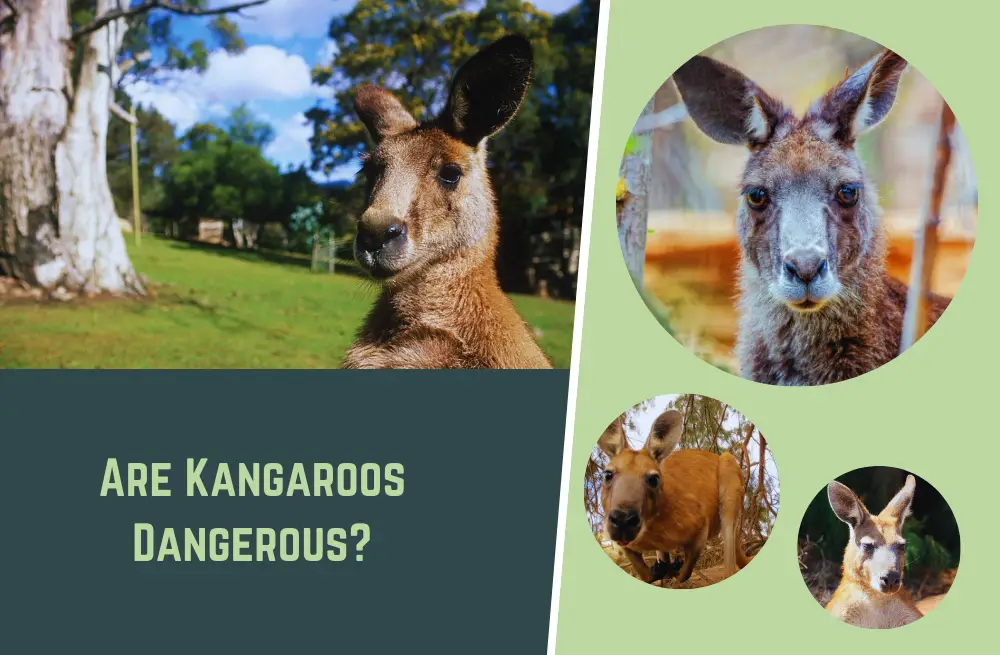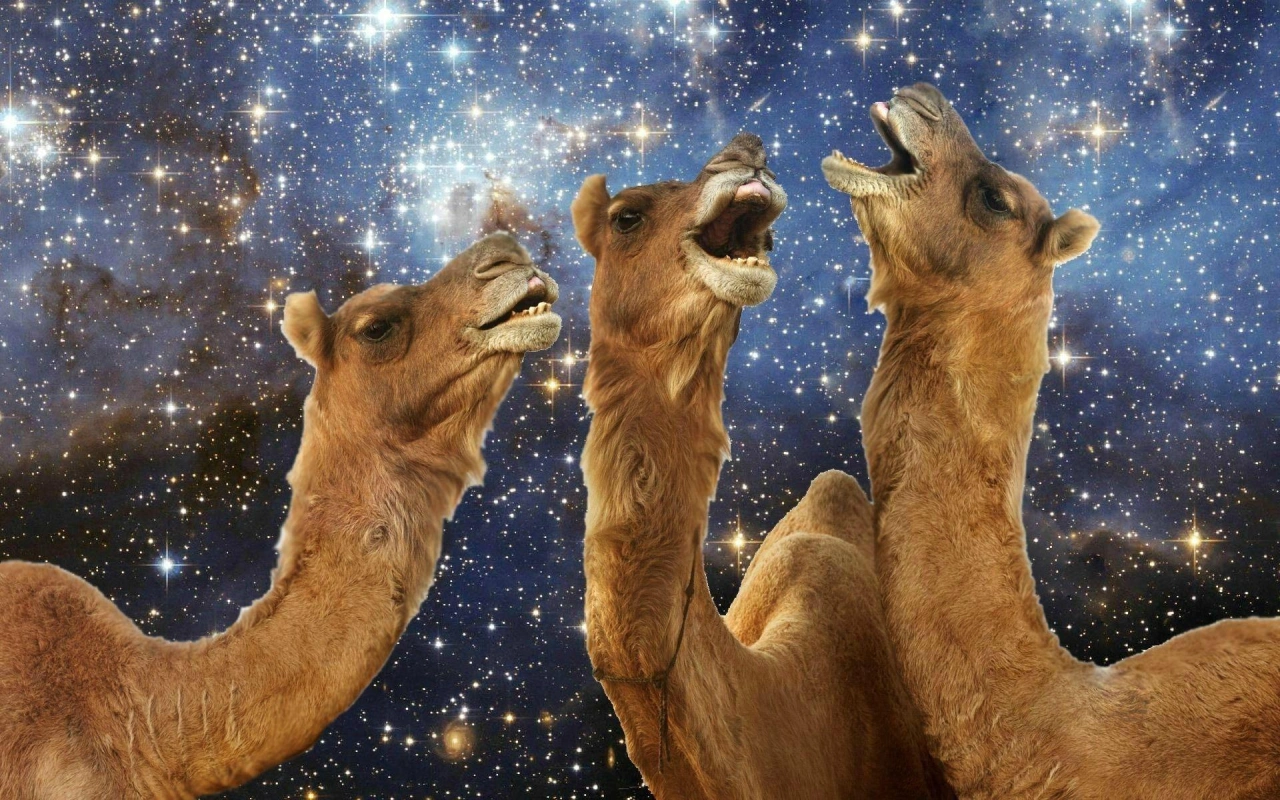The Red Kangaroo, scientifically known as Macropus rufus, is a magnificent and iconic kangaroo species that captures the imagination with its size, strength, and remarkable adaptations.
As the largest kangaroo species and the largest marsupial in the world, the Red Kangaroo holds a prominent place in Australian wildlife.
So let’s explore the dry, but amazing world of the Red Kangaroo, delving into its physical characteristics, habitat, behavior, and significance in Australian culture and ecosystems.
Let’s gooooooooooo! 🦘
Overview
| Characteristic | Red Kangaroo |
|---|---|
| Scientific Name: | Macropus rufus |
| Family: | Macropodidae |
| Type: | Mammal |
| Order: | Diprotodontia |
| Temperament: | Generally docile, can be aggressive if threatened |
| Lifespan: | Up to 23 years in the wild, up to 20 years in captivity |
| Size: | Length: 85–105 cm (33–41 in) Tail length: 65–85 cm (26–33 in) |
| Weight: | Females: 18–40 kg (40–88 lb) Males: 55–90 kg (121–198 lb) |
| Diet: | Primarily grasses, forbs, shrubs, and chenopods |
| Distribution: | Western and central Australia |
| Habitat: | Scrubland, grassland, and desert habitats with some trees for shade. |
| Conservation Status: | Least Concern (IUCN) |
| Fun Fact: | Red kangaroos are the largest marsupials and known for their impressive hopping ability, reaching speeds of up to 56 km/h (35 mph). |
Physical Characteristics of Red Kangaroos
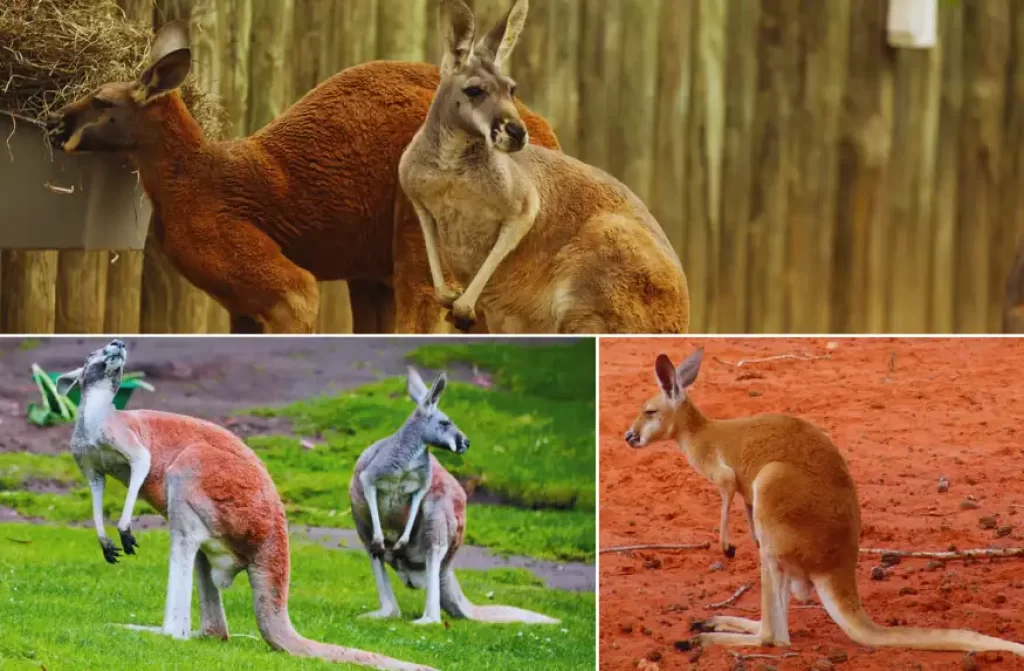
Red Kangaroos are distinguished by their large size and unique physical features. Adult males, known as boomers, can reach a height of up to 1.8 meters (6 feet) and weigh between 55 to 90 kilograms (120 to 200 pounds), with some exceptional individuals exceeding these measurements. Females, called flyers, are generally smaller, standing around 1.2 to 1.4 meters (4 to 4.6 feet) tall and weighing 17 to 40 kilograms (37 to 88 pounds).
The name “Red Kangaroo” comes from the rusty-red color of their fur, which provides excellent camouflage in the arid and sandy landscapes they inhabit. Their fur also acts as insulation, helping them endure the harsh Australian climate.
They have long, muscular hind legs built for powerful hopping, a characteristic that defines all kangaroo species. Their strong tails, used for balance and support, can be as long as their bodies and are essential for their distinctive form of locomotion.
Regulating Body Temperature in Extreme Conditions
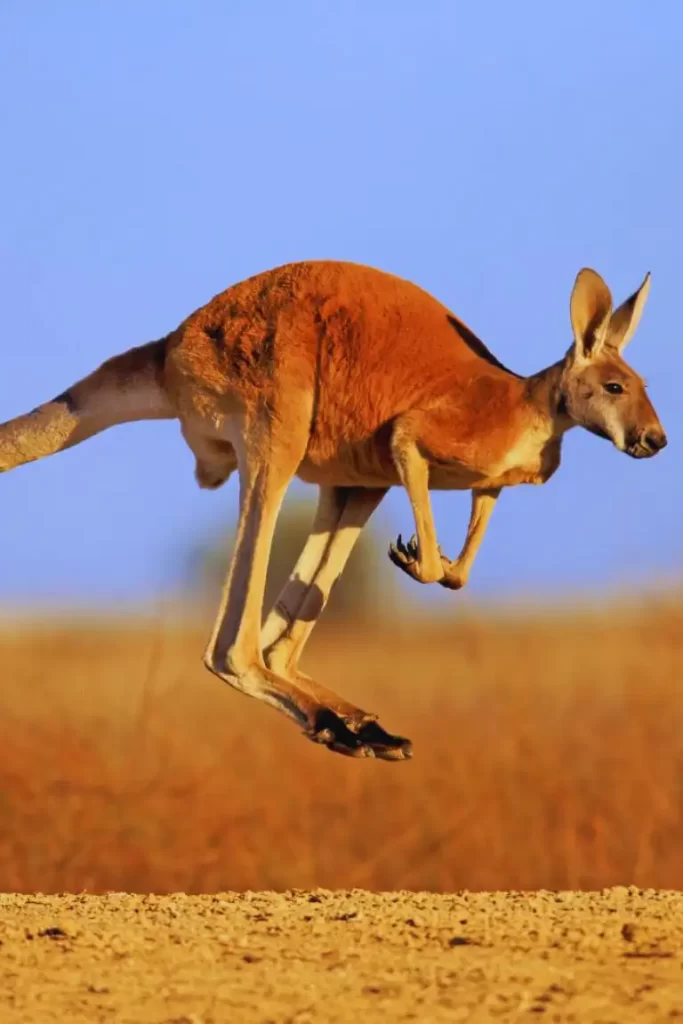
The red kangaroo, an iconic Australian marsupial, is well adapted to the challenging conditions of its arid habitat. With scorching temperatures and limited resources, red kangaroos have evolved remarkable strategies to regulate their body temperature and survive in extreme heat
These are the mechanisms employed by these kangaroos to stay cool and maintain their internal balance in the face of blistering temperatures:
Insulating Fur
A Protective Shield One of the key adaptations of red kangaroos is their dense fur, which acts as a natural insulation layer. This fur traps air close to their bodies, creating a buffer against the external heat. This insulating barrier helps to prevent the kangaroos from absorbing excessive heat and maintains a more stable body temperature.
Reduced Activity
Slowing Down to Beat the Heat During periods of intense heat, red kangaroos minimize their activity levels. They conserve energy by resting in the shade and reducing movement, which helps reduce heat production. By slowing down, they can avoid additional heat build-up and preserve vital energy resources.
Seeking Shelter
The Quest for Shade Red kangaroos actively seek out shade as a strategy to escape the direct heat of the sun. They take refuge under trees, bushes, or any available shade-providing objects. By positioning themselves in shaded areas, they can significantly reduce their exposure to the scorching rays of the sun, thereby avoiding overheating.
Panting
The Cooling Breath Similar to dogs, red kangaroos employ panting as a cooling mechanism. Panting helps them regulate their body temperature by evaporating moisture from their respiratory system. As they pant, moisture evaporates, carrying away excess heat from their bodies and providing a cooling effect.
Sweating and Licking
Nature’s Cooling System Red kangaroos possess sweat glands on their forelimbs, which allow them to sweat. They spread the sweat over their bodies by licking their forelimbs. This process aids in evaporative cooling, similar to panting, and assists in dissipating heat from their bodies.
Behavioral Adaptations
Heat-Evading Strategies In addition to physical adaptations, red kangaroos display behavioral adaptations to combat extreme heat. They exhibit a preference for resting during the hottest parts of the day, avoiding unnecessary movement and exposure to the sun’s intensity. By timing their activities to cooler periods, they conserve energy and minimize heat stress.
Surviving and Thriving in Australia’s Diverse Landscapes
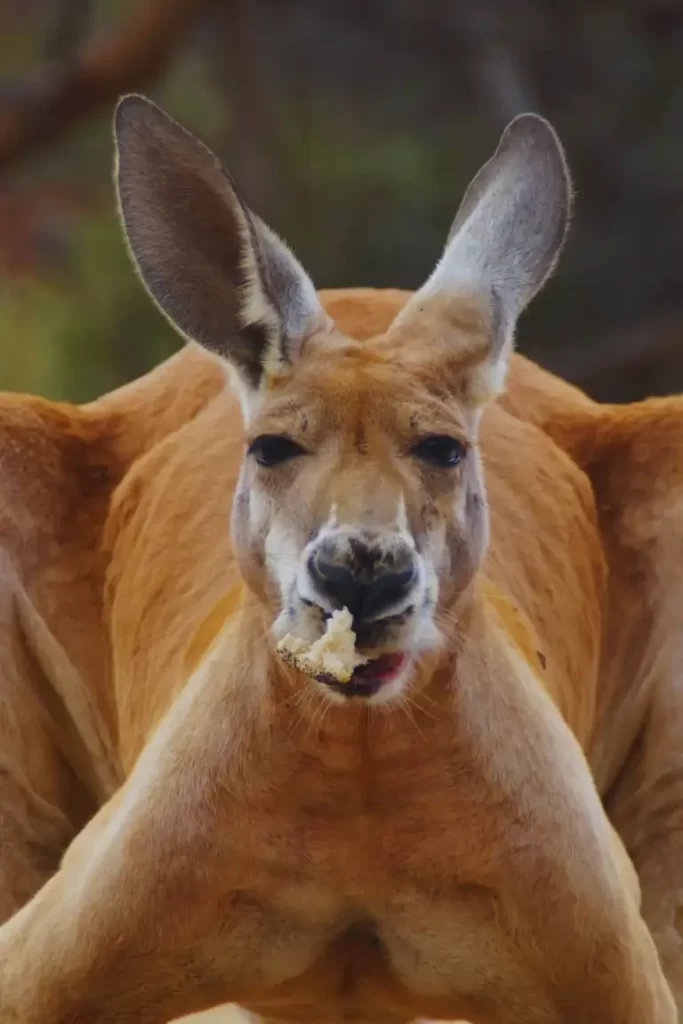
Australia is home to a remarkable array of unique wildlife, and among its most iconic species is the red kangaroo. With its impressive size and ability to adapt to various habitats, this kangaroo has captured the imagination of people around the world.
Let’s explore the ecology, habitat, and survival strategies of the red kangaroo, shedding light on how it manages to thrive in Australia’s diverse landscapes.
Ecology and Habitat
The red kangaroo, scientifically known as Macropus rufus, ranges across western and central Australia. It is a species that can be found in a range of environments, from scrublands and grasslands to the arid expanses of the desert.
While it can adapt to different habitats, the red kangaroo favors open areas with some trees that provide much-needed shade and shelter.
Surviving in arid conditions is a challenge, but the red kangaroo possesses remarkable adaptations to cope with the harsh Australian climate.
One of its most impressive abilities is water conservation. These kangaroos have highly efficient kidneys that concentrate urine, enabling them to conserve water effectively, particularly during the dry summer months when water sources are scarce.
Diet and Foraging
As herbivores, red kangaroos rely on a plant-based diet to meet their nutritional needs. Their preferred food includes green vegetation, particularly fresh grasses and forbs.
Even when most plants appear brown and dry, these kangaroos have the remarkable ability to select and consume enough green vegetation to sustain themselves.
In Central Australia, where the red kangaroo population thrives, green grass makes up a significant portion of their diet, often ranging from 75% to 95%.
A dominant grass species called Eragrostis setifolia plays a crucial role in their sustenance, remaining green even during the dry season. When drought strikes, red kangaroos actively search for green plants, strategically staying in open grasslands and near watercourses to increase their chances of finding nourishment.
Predation and Defense
Despite their impressive size, red kangaroos are not entirely immune to predation. While they are generally safe from predators due to their robust build and powerful kicks and blows, young joeys may be vulnerable to threats.
Dingoes, which are wild dogs, and birds of prey, such as wedge-tailed eagles, occasionally target young kangaroos. In some areas, saltwater crocodiles pose a risk, especially near water bodies. Nevertheless, kangaroos are adept swimmers and can use their forepaws to hold predators underwater, defending themselves when necessary.
Behaviour of the Red kangaroo
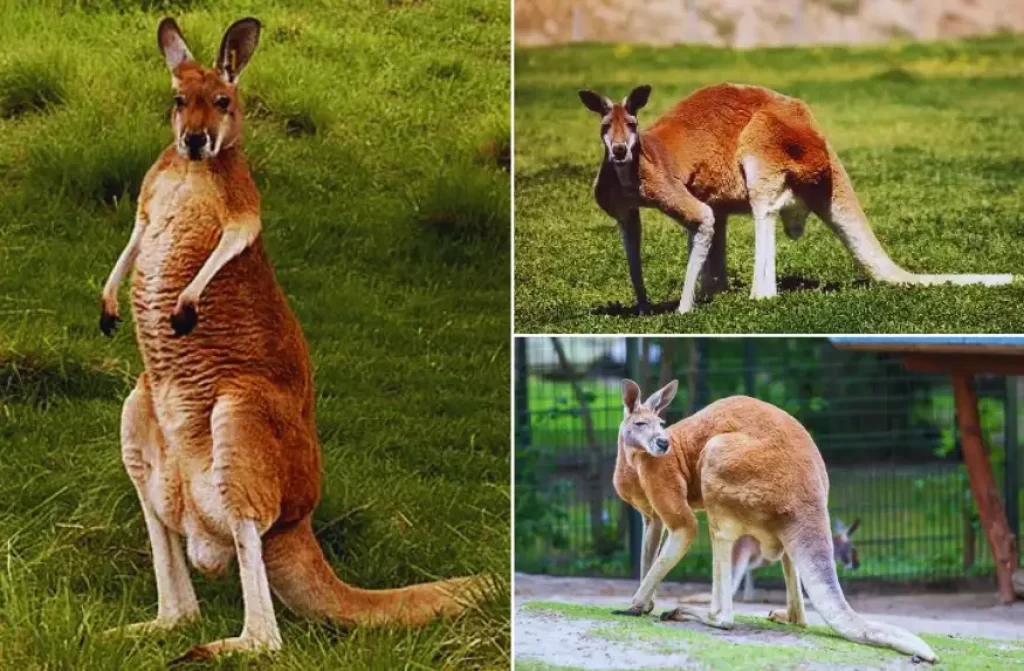
Red kangaroos, as social animals, exhibit interesting behaviors within their groups. They typically live in small groups consisting of 2 to 4 individuals, with the most common composition being females and their young. In areas with higher population density, larger groups can be observed, often with females accompanied by a male.
The social structure of red kangaroo groups is quite flexible, with membership changing as individuals come and go.
Unlike many other species, male red kangaroos, known as boomers, are not territorial. They do not establish specific territories but instead focus their interactions on females, referred to as flyers, during breeding season.
During mating season, male kangaroos undergo physical changes, developing significantly larger shoulders and arms compared to females. Agonistic interactions, or confrontations, mainly occur between young males.
They engage in ritualized fighting known as boxing, where they stand on their hind limbs and attempt to push their opponent off balance by jabbing or locking forearms.
If the conflict escalates, kicking with powerful hind legs comes into play. The tail acts as support, allowing them to deliver strong kicks. Compared to other kangaroo species, fights between male red kangaroos often involve more wrestling.
These fights serve to establish dominance relationships among males and determine access to females in estrus. Dominant males exhibit both agonistic behaviors and more sexual behaviors toward females. However, their dominant status is not permanent, as younger and stronger males may eventually challenge and overthrow them.
Displaced males, who have been defeated or are lower in the hierarchy, tend to live solitarily and avoid close contact with other males.
These social dynamics play a crucial role in the reproductive success of red kangaroos. By engaging in combat and establishing dominance, males increase their chances of mating with receptive females, ensuring the continuation of their genetic lineage.
Reproduction and Parental Care
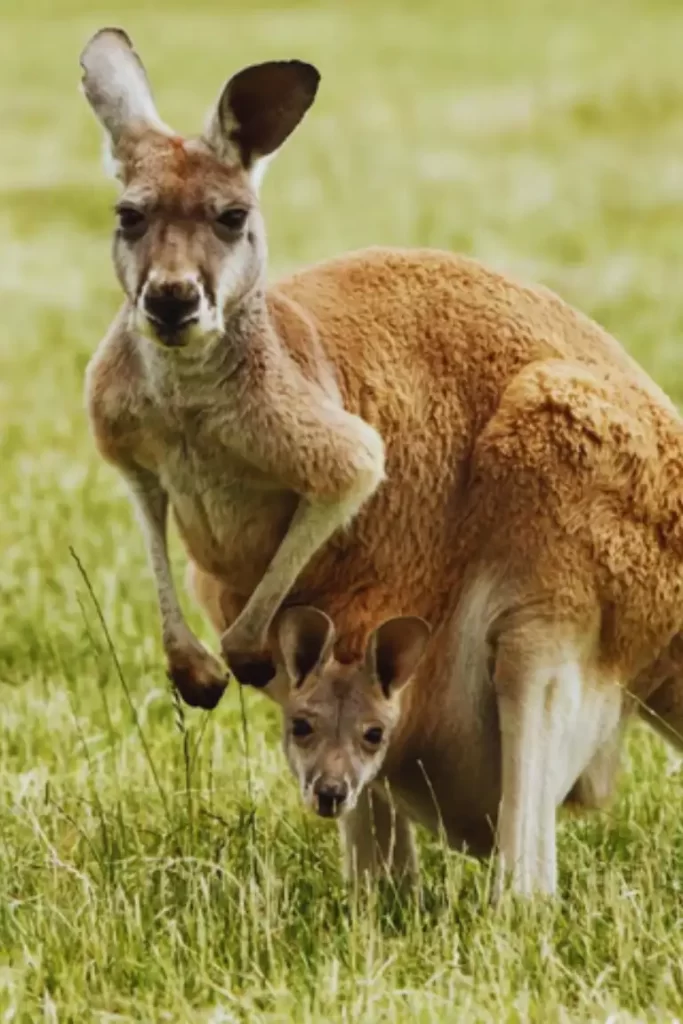
The red kangaroo showcases remarkable reproductive adaptations and unique parental care behaviors. With the ability to delay the birth of their young and engage in complex reproductive cycles, red kangaroos exhibit fascinating strategies for ensuring the survival of their offspring.
Embryonic Diapause: Nature’s Timing Miracle
One of the most astonishing aspects of red kangaroo reproduction is the ability of females to practice embryonic diapause. This means that a female can delay the development of her embryo until her previous joey has left the pouch.
This remarkable adaptation allows the female to optimize the survival chances of her young, ensuring that resources and maternal care are available when needed.
The Reproductive Process: From Copulation to Birth
Copulation in red kangaroos is a relatively long process, lasting about 25 minutes. Females have a unique reproductive system common among kangaroos.
After a short gestation period of just 33 days, the neonate, blind and hairless, emerges from the birth canal. Unlike other kangaroo species, red kangaroos typically give birth to only one young at a time.
The Journey to the Pouch: A Race for Survival
Once the neonate emerges, it quickly climbs its way through the thick fur on its mother’s abdomen using its forelegs. Within a few minutes, it reaches the pouch and attaches itself to one of the two teats to feed.
Remarkably, the mother’s sexual cycle restarts immediately after birth, and if she mates again and a second egg is fertilized, its development is temporarily halted.
This unique reproductive process ensures that the mother can support the growing joey in her pouch while simultaneously preparing for the next reproductive cycle.
Growing Independence: Leaving the Pouch
As the joey grows inside the pouch, it reaches a stage of development where it begins to venture outside, sticking its head out to explore the world around it. After approximately 190 days, the joey is fully developed and ready to leave the pouch for longer periods.
Around 235 days old, it takes its final leap from the pouch, embracing the outside world. However, it will continue to suckle from its mother until it reaches about 12 months of age.
Parental Care and Alloparental Behaviors
Red kangaroo mothers exhibit incredible parental care, providing nourishment and protection to their young.
They produce milk tailored to the specific needs of the joey at each stage of development. Additionally, red kangaroos have been observed engaging in alloparental care, where a female may adopt and care for another female’s joey.
This cooperative behavior ensures the survival and well-being of multiple generations simultaneously.
Red Kangaroos: Coexistence, Challenges, and Commercial Uses
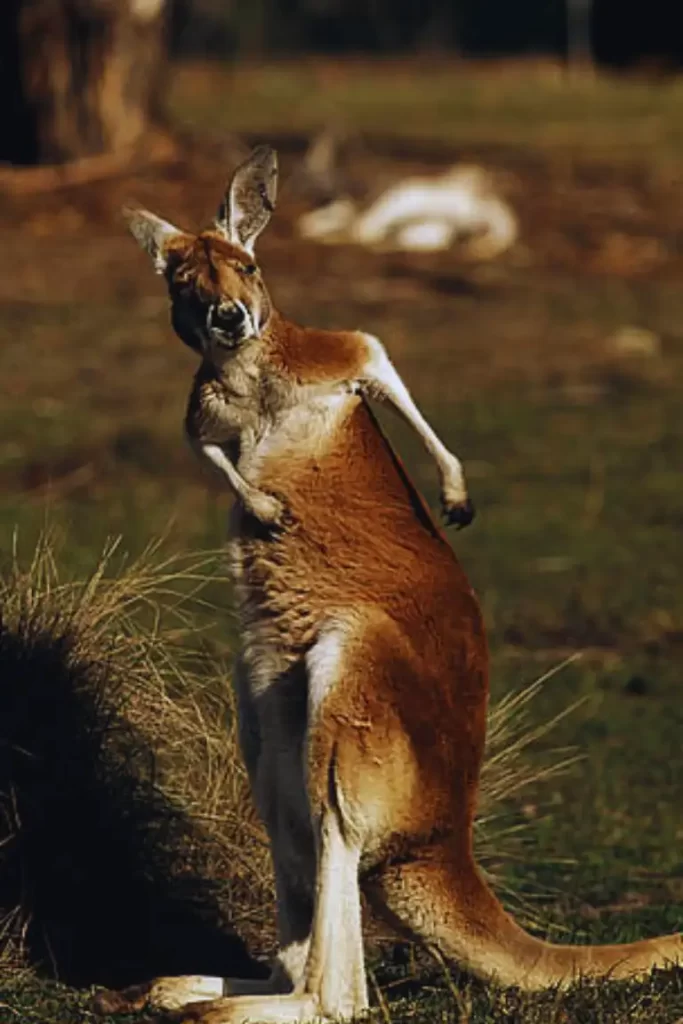
The red kangaroo, an iconic Australian species, shares a complex relationship with humans. While it has benefited from certain human activities, it also faces challenges and is subject to regulated commercial use.
Okay guys so let’s explore the dynamics of the red kangaroo’s relationship with humans, including its impact on agriculture, road safety concerns, and commercial uses.
Coexistence and Challenges
The red kangaroo population has thrived in certain areas due to the spread of agriculture and the creation of man-made waterholes.
These changes in the landscape have provided favorable conditions for their survival. However, the kangaroo also faces challenges, particularly in competition with livestock and rabbits.
Some farmers view them as pests and may obtain a “destruction permit” from the relevant state government to address conflicts between kangaroos and agricultural activities.
Road Safety Concerns
The interaction between red kangaroos and vehicles presents a significant challenge. Kangaroos can be dazzled by headlights or startled by engine noise, leading them to leap in front of vehicles. This behavior can result in severe damage or destruction of smaller or unprotected vehicles.
The risk of harm to vehicle occupants is heightened, especially if the point of impact is the windscreen. Consequently, “kangaroo crossing” signs are common on Australian roads. Peak times for kangaroo-vehicle collisions are typically between 5:00 PM and 10:00 PM, during winter, and after extended dry spells.
Commercial Uses and Regulation
While the red kangaroo is protected by legislation, its abundance allows for regulated harvest of its hide and meat. Harvesting permits and commercial practices are carefully managed under nationally approved plans.
The goal is to maintain red kangaroo populations and utilize them as a renewable resource. However, the commercial harvesting of kangaroos remains controversial, primarily due to the kangaroo’s popularity and public sentiment towards wildlife conservation.
Commercial Uses and Industry
The kangaroo industry plays a significant role in the Australian economy. The number of red kangaroos available for commercial use is regulated, with a limit set by the government. In 2009, the limit was set at 1,611,216 red kangaroos.
The industry is estimated to be worth around A$270 million annually and provides employment opportunities for over 4,000 people. Kangaroo meat, known for its leanness and low fat content (approximately 2%), is consumed by humans and used in pet food. Additionally, the skins of harvested kangaroos are used for leather production.
Note: The red kangaroo’s relationship with humans is multifaceted, encompassing both benefits and challenges.
Conservation Status and Cultural Significance of the Red Kangaroo
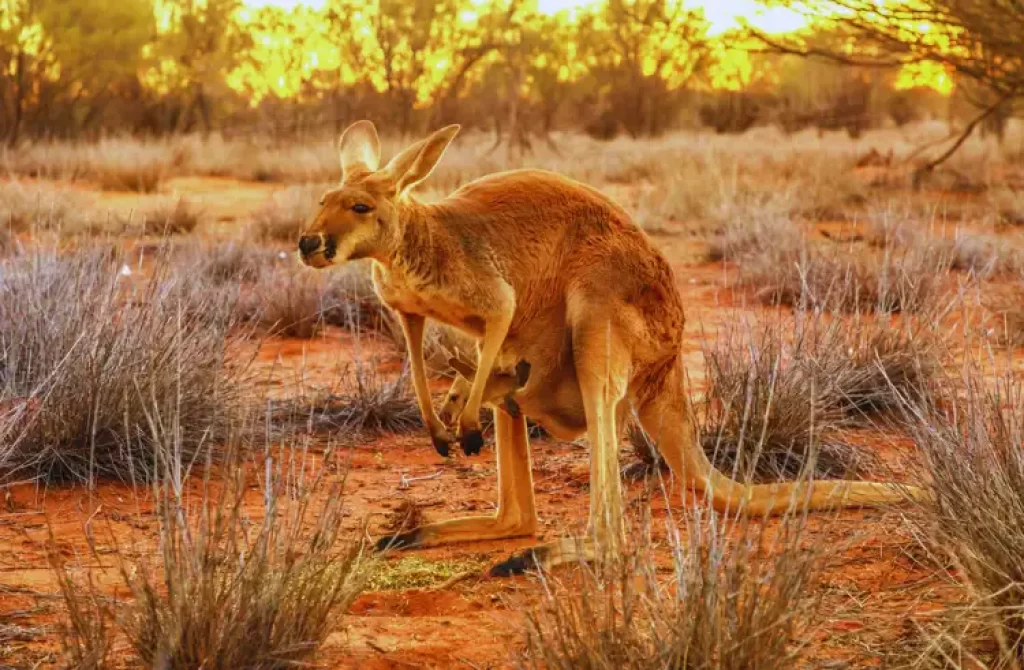
The Red Kangaroo holds significant cultural importance in Australia, where it is regarded as a national symbol and an emblem of the country’s unique wildlife.
However, despite their cultural significance and adaptability to harsh environments, Red Kangaroos face various challenges in the wild.
Habitat loss, climate change, and human activities, such as hunting and vehicle collisions, can impact their populations.
Efforts are being made to protect and conserve Red Kangaroos through wildlife management programs, protected areas, and conservation initiatives. These actions aim to ensure the long-term survival of this iconic species and maintain the delicate balance of Australia’s ecosystems.
Related animals
Conclusion
The Red Kangaroo, with its impressive size, agility, and adaptation to arid environments, represents the awe-inspiring diversity of Australian wildlife. Its role as a symbol of Australia’s unique fauna and its ecological significance make it a cherished and respected species.
By understanding the biology, behavior, and conservation needs of the Red Kangaroo, we can appreciate the importance of protecting and preserving this extraordinary marsupial for future generations. 😌
To delve deeper into the captivating world of kangaroos and explore the diverse wildlife of Australia, we invite you to explore more articles on our website, where you can discover the wonders of nature and the intricate connections that shape our natural world.
Frequently Asked Questions (FAQ)
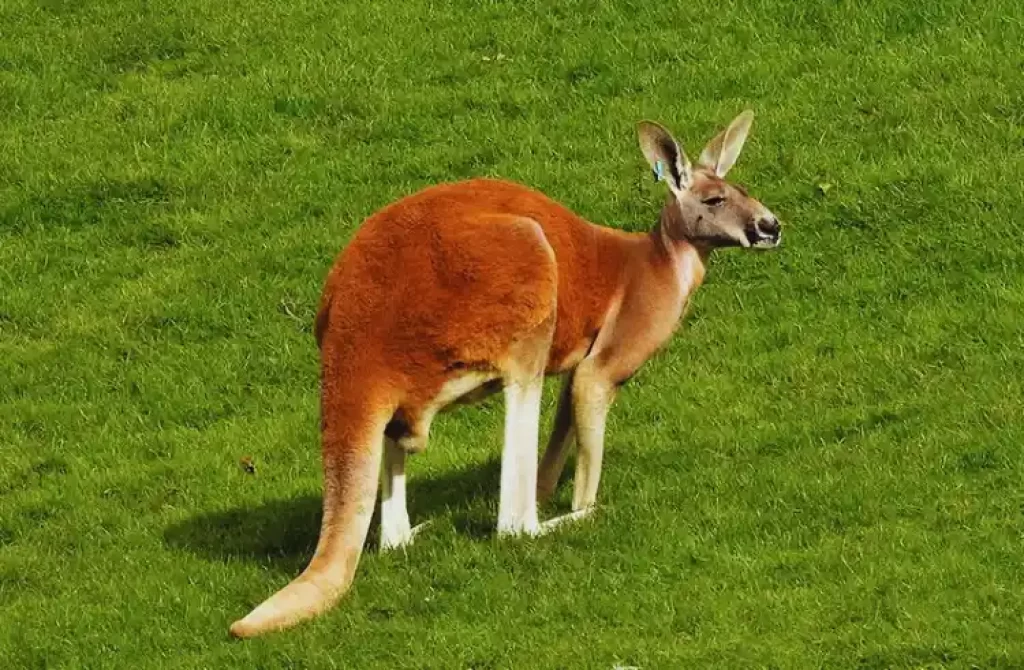
What is the difference between red and grey kangaroos?
Red kangaroos (Macropus rufus) and grey kangaroos (Macropus giganteus) are two kangaroo species found in Australia. Here are some key differences these 2 species:
- Size: Red kangaroos are larger, with males reaching 1.8 meters (6 feet) tall and weighing around 90 kilograms (200 pounds). Grey kangaroos are slightly smaller, with males reaching 1.3 meters (4 feet) in height and weighing about 66 kilograms (145 pounds).
- Color: Red kangaroos have a reddish-brown coat, while grey kangaroos have a predominantly grey color.
- Habitat: Red kangaroos inhabit arid and semi-arid regions, while grey kangaroos have a wider range, including woodlands, grasslands, and coastal areas.
- Social Behavior: Red kangaroos are usually solitary or in small groups, while grey kangaroos are more social and form larger groups called “mobs” or “troops.”
- Diet: Red kangaroos primarily feed on grasses and forbs, while grey kangaroos have a more varied diet, including grasses, shrubs, and some tree leaves.
- Distribution: Red kangaroos are commonly found in central and western Australia, while grey kangaroos have a broader distribution across various parts of the country.
These are the main differences between red and grey kangaroos.
Are red kangaroos dangerous?
Red kangaroos are generally not dangerous, but they can become aggressive if threatened. It’s important to give them space and not provoke them.
What do red kangaroos eat?
Red kangaroos primarily feed on vegetation, with a diet consisting mainly of green grasses and forbs. They have a remarkable ability to find and consume fresh vegetation even in arid environments where most plants appear dry and brown.
During the dry season, they search for green plants by staying in open grasslands and near watercourses. While grasses and forbs are their preferred food, red kangaroos can also eat certain species of chenopods and browse on shrubs when their favored foods are scarce.
However, they tend to avoid certain perennial chenopods even when they are abundant. Overall, their diet is well-suited to their environment and enables them to survive and thrive in various habitats across their range.
Do red kangaroos eat meat?
No, red kangaroos are herbivores and do not eat meat. Their diet consists primarily of vegetation, including green grasses, forbs, and certain types of plants. They have specialized adaptations for grazing on vegetation and extracting nutrients from plant material.
While kangaroos are known to have a diverse diet, ranging from different types of grasses to browse on shrubs, they do not consume meat or engage in carnivorous behavior. Their digestive system is specifically designed for processing plant matter, and they rely on their ability to find and consume vegetation to meet their nutritional needs.
Up Next:
